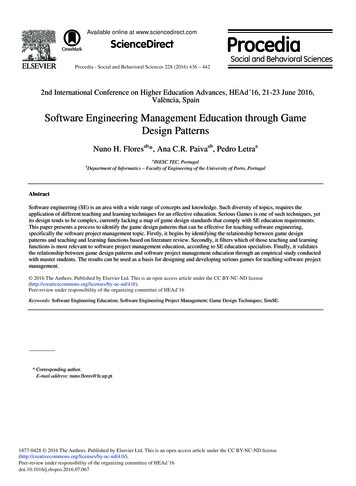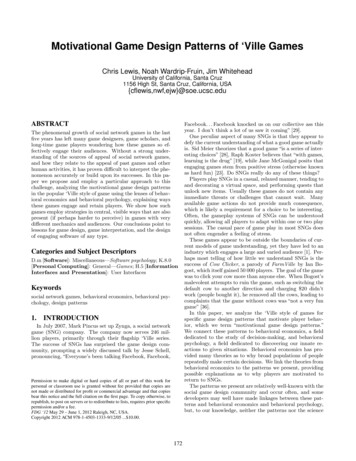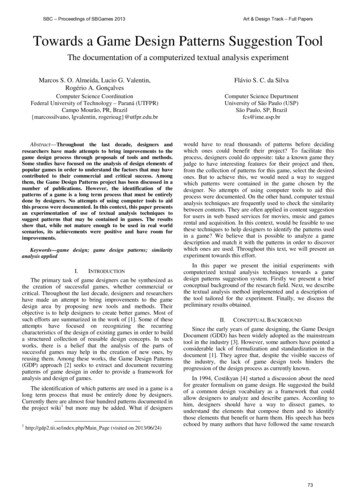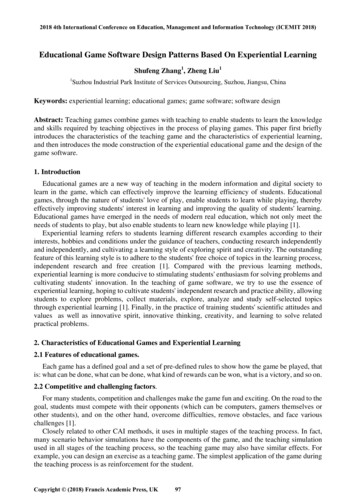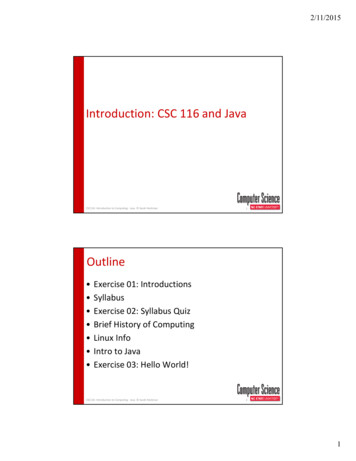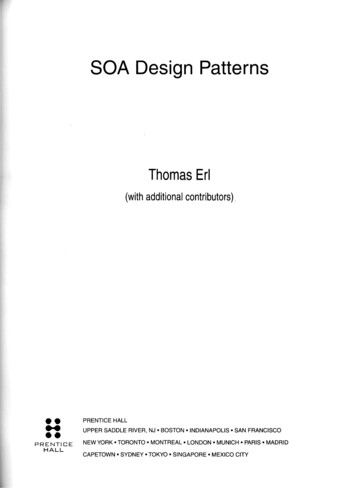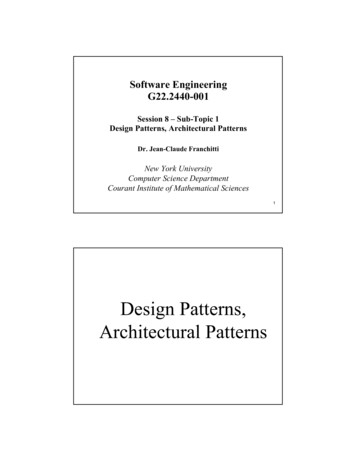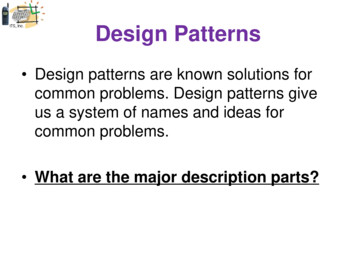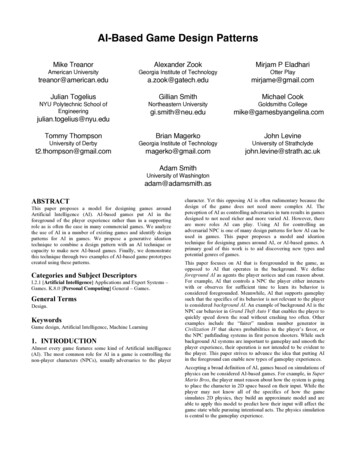
Transcription
AI-Based Game Design PatternsMike TreanorAlexander ZookMirjam P EladhariAmerican UniversityGeorgia Institute of TechnologyOtter mail.comJulian TogeliusGillian SmithMichael CookNYU Polytechnic School ofEngineeringNortheastern UniversityGoldsmiths @gamesbyangelina.comTommy ThompsonBrian MagerkoJohn LevineUniversity of DerbyGeorgia Institute of TechnologyUniversity of ohn.levine@strath.ac.ukAdam SmithUniversity of Washingtonadam@adamsmith.asABSTRACTThis paper proposes a model for designing games aroundArtificial Intelligence (AI). AI-based games put AI in theforeground of the player experience rather than in a supportingrole as is often the case in many commercial games. We analyzethe use of AI in a number of existing games and identify designpatterns for AI in games. We propose a generative ideationtechnique to combine a design pattern with an AI technique orcapacity to make new AI-based games. Finally, we demonstratethis technique through two examples of AI-based game prototypescreated using these patterns.Categories and Subject DescriptorsI.2.1 [Artificial Intelligence] Applications and Expert Systems –Games. K.8.0 [Personal Computing] General – Games.General TermsDesign.KeywordsGame design, Artificial Intelligence, Machine Learning1. INTRODUCTIONAlmost every game features some kind of Artificial intelligence(AI). The most common role for AI in a game is controlling thenon-player characters (NPCs), usually adversaries to the playercharacter. Yet this opposing AI is often rudimentary because thedesign of the game does not need more complex AI. Theperception of AI as controlling adversaries in turn results in gamesdesigned to not need richer and more varied AI. However, thereare more roles AI can play. Using AI for controlling anadversarial NPC is one of many design patterns for how AI can beused in games. This paper proposes a model and ideationtechnique for designing games around AI, or AI-based games. Aprimary goal of this work is to aid discovering new types andpotential genres of games.This paper focuses on AI that is foregrounded in the game, asopposed to AI that operates in the background. We defineforeground AI as agents the player notices and can reason about.For example, AI that controls a NPC the player either interactswith or observes for sufficient time to learn its behavior isconsidered foregrounded. Meanwhile, AI that supports gameplaysuch that the specifics of its behavior is not relevant to the playeris considered background AI. An example of background AI is theNPC car behavior in Grand Theft Auto V that enables the player toquickly speed down the road without crashing too often. Otherexamples include the “fairer” random number generator inCivilization IV that skews probabilities in the player’s favor, orthe NPC pathfinding systems in first person shooters. While suchbackground AI systems are important to gameplay and smooth theplayer experience, their operation is not intended to be evident tothe player. This paper strives to advance the idea that putting AIin the foreground can enable new types of gameplay experiences.Accepting a broad definition of AI, games based on simulations ofphysics can be considered AI-based games. For example, in SuperMario Bros, the player must reason about how the system is goingto place the character in 2D space based on their input. While theplayer may not know all of the specifics of how the gamesimulates 2D physics, they build an approximate model and areable to apply this model to predict how their input will affect thegame state while pursuing intentional acts. The physics simulationis central to the gameplay experience.
Super Mario Bros makes use of what have been called “graphicallogics” because the player’s understanding of its physicssimulation is achieved via visually represented entities movingand interacting on a screen [14]. This can be consideredforeground AI, as the player’s understanding of the system iscentral to how they make choices. This idea of putting avisualization of the physics simulation central to a game suggeststhat visualizations of other AI systems might make for interestinggames. For example, what types of games could be made when asocial simulation, or a learning algorithm are visualized and madecentral to gameplay? We present several such design patterns forhow foreground AI can be used to make new types of games.As part of this effort, we analyze how AI is used in severalexisting games and identify design patterns for AI in games. Wepropose a generative ideation technique to combine a designpattern with an AI technique or capacity to make new AI-basedgames. Finally, we demonstrate this technique through twoexamples of AI-based game prototypes created using thesepatterns.2. RELATED WORKOur argument for the value of foregrounding AI in game and ourdesign pattern-based taxonomy builds upon prior research indesign patterns, theoretical frameworks for understanding games,and analysis of existing AI-based games.A design pattern approach to describing games and game contentallows us to build a common vocabulary for discussing games,identify common elements between games at the mechanical andplayer levels, and reason about the structure of games [2, 9, 17,19]. Design patterns are typically descriptive and informal, drawnfrom a close analysis of multiple source games. The patternsthemselves typically have a short name, a description of how thepattern is abstracted across games, and several motivatingexamples to show the capacity of the pattern to describe a varietyof scenarios across multiple games. Our pattern taxonomy followsthe same model: the games we analyzed to extract our patternscome from diverse developers, including large industry studios,academic research, and independent development.Though the primary purpose of design patterns is typically toprovide an analytical lens, they also have the potential to be usedgeneratively. Hullett and Whitehead’s [9] FPS level patterns wereevaluated via the deliberate design of levels that incorporate thosepatterns. Dahlskog and Togelius’s [4] pattern-based platformerlevel generator takes this one step further, formalizing the patternsto the extent that a computer can perform the pattern-baseddesign. We pose that the patterns we have identified can be usedgeneratively during the ideation phase of design, to allow us toconsider new kinds of playable experiences.Our taxonomy also builds on previous work in understanding therole of AI in games and the potential it holds for the future ofgames. Mateas [13] calls for the creation of “expressive AI”:playable experiences with complex underlying AI systems whereall interaction is framed by the player needing to read meaninginto the AI’s actions. Eladhari et al. [5] describe a process fordesigning games where the AI system is an integral part of thegame’s design. They distill a common process followed during thedesign of four games: the Pataphysic Institute [6], Prom Week[15], Mismanor [18], and Endless Web [16]. With Endless Web,Smith et al. pose that an AI-based game is one where themechanics, dynamics, and aesthetics of the game [10] are deeplylinked to the AI system. More recent games designed around theirAI system include Horswill’s MKULTRA [8] and Cook’s A RogueDream [3].3. DESIGN PATTERNSBelow we discuss several design patterns for AI-based games.These patterns illustrate ways to develop a game mechanicstarting from an AI technique (e.g., AI is Visualized) or startingfrom an intended experience that requires AI (e.g., AI as Rolemodel). The design patterns and example games are meant to be atool for thinking about creating AI-based games, rather than serveas a comprehensive taxonomy of methods. Note also that multipletechniques may apply to a single game: Table 1 provides anoverview of these patterns and game examples.3.1 AI is VisualizedPattern: Provide a visual representation of the underlying AIstate, making gameplay revolve around explicit manipulation ofthe AI state.Explanation: Many AI techniques revolve around an estimationof the value of actions or game states. Typically these values arehidden from players to promote the sense that an opposing AIagent possesses an intelligence motivating its actions. Visualizingthe state of a system or agent enables gameplay as the system isnow exposed as a potential obstacle to player progress.Example: Third Eye Crime [11] is a stealth game that illustratesthis pattern by visualizing the guard AI position tracking andestimation system. Gameplay involves avoiding guards orthrowing distractions to manipulate the guards’ predictions ofplayer location. The direct visualization of AI state allows adesigner to build a game around manipulating, understanding, andmentally modeling how the AI state changes.3.2 AI as Role-modelPattern: Provide one or more AI agents for the player to behavesimilarly to.Explanation: AI techniques to date often demonstrate stronglypatterned behavior that players come to predict: e.g., finite statemachines (FSMs) follow fixed routines that can often be easilynoticed. Rather than attempt to make agent behavior moreunpredictable, this pattern leverages the behavioral rigidity of atechnique to set a stage for the player to act on. Gameplay in thispattern involves acting to mimic the behaviors of AI agents,leading to an “imitation game” judged by an in-game system oropposing players.Example: Spy Party is a game where one player is a spy at a partypopulated by FSM agents and the opposing player is a sniperwatching the party with a single shot to kill the spy. Gameplay forthe spy centers on the player attempting to act similarly to theparty agents while discreetly performing tasks in the environmentlike planting a bug or reading a code from a book. Gameplay forthe sniper focuses on discerning the human player from AI agentsby looking for behavioral cues that differentiate the two. Animitation game thus forces players to explicitly reason about theprocesses followed by an AI technique.3.3 AI as TraineePattern: Have player actions train an AI agent to perform taskscentral to gameplay.Explanation: Machine learning techniques revolve aroundlearning new behaviors using examples. By using player actionsas a source of examples an AI agent can learn to perform tasks,
Table 1. An overview of AI-based game design patterns and game examples.PatternWhat player(s) doRole of AI (in relation to player)Example(s)AI is VisualizedObserve AI stateGives (strategic) information, showing statesThird Eye CrimeAI as Role-modelImitate AIShow agent actionas and behaviors, agents aspuzzlesSpy PartyAI as TraineeTeach AIChild/studentBlack & WhiteAI is EditableEdit AIArtifact/agent that player can author/manipulateGalactic Arms RaceAI is GuidedGuide/manage the AIPartly independent inhabitants, with players astheir GodsThe SimsAI as Co-creatorMake artifacts assistedby AICo-creator, making artifactsViewPoints AIAI as AdversaryPlay game against theopponentOpponent (symmetric)Chess, GoAI as VillainCombat the Villain(s)Villain in game; mob, boss mob, NPC(asymmetric)Alien IsolationAI as SpectacleObserveSpectacle, enacting simulated societyNowherewith this indirect control (or automation) becoming central toplayer activity in a game. Note that many paradigms for trainingexist. Supervised learning requires players to explicitly providefeedback by labeling examples as indicative of a behavior.Unsupervised learning abstracts from examples without explicitguidance. Reinforcement learning uses feedback about the valueof actions, rather than labels describing what an action was. Eachof these paradigms provides opportunities for different kinds ofplayer action in a game to indirectly control game outcomes.Example: Black & White [1] is a god game where the playertrains a creature to act as an autonomous assistant in spatialregions where the player cannot take direct action. The creaturelearns sets of behaviors through a reward signal based on a needsmodel; the creature also takes direct feedback through playeraction (e.g., slapping or petting the creature after it takes actions).Players cannot directly control the actions of the creature, butinstead rely on feedback to train the creature to perform actionsthat align with the player’s desired strategy. By training AI agentsplayers are required to consider behind how an agent learns, evenwithout direct representation of that process.3.4 AI is EditablePattern: Have the player directly change elements of an AI agentthat is central to gameplay.Explanation: Most AI techniques have parameters (e.g., weightsin a neural network) or other data structures (e.g., nodes in abehavior tree) that can be directly changed to manipulate agentbehavior. Typically these are created and tuned at design time andremain fixed and hidden during the running time of a game.Providing players with direct access to manipulate theseparameters can be the foundation for a game about player indirectaction via an AI agent. Note that direct player editing cansupplement indirect player training (e.g., as an alternate gameplaymode or resource-gated mechanic).Example: Galactic Arms Race [7] is a space shooter where howthe player uses different weapons evolves an underlying neuralnetwork representation to change weapon firing behavior. Basegameplay revolves around finding a set of firing behaviors thattogether enable a player to succeed at destroying opposition(another example of the AI as Trainee pattern). One gameplaymode allows the player to explicitly manipulate the networkweights on weapons, allowing more precise control over the firingpatterns of the evolved weapons. This control enables players tomore finely explore the space of parameterizations, leading to anindirect way to understand the processes of the AI system.3.5 AI is GuidedPattern: The player assists a simple or brittle AI agent that isthreatened with self-destruction.Explanation: Many AI algorithms are brittle and likely to breakunless constrained to highly limited environment. Rather thanavoid exposing the AI to situations where its behavior would bedetrimental, build gameplay around the player acting to avoidthose situations. Gameplay then emphasizes players acting aroundthe AI to protect it or directly acting to continually maintain theAI in the face of gradual degradation.Example: The Sims addressed the problem of “human-like”agents in a social world by making gameplay revolve around theplayer addressing the needs of simple agents. AI agents have a setof needs and desires they attempt to pursue while playersintervene to provide for the needs of the agents through food,shelter, work, socialization, and eventually more grand lifeaspirations. By having players care for the AI, players come to (atleast indirectly) model some of the processes used by the AI.3.6 AI as Co-creatorPattern: Involve the player in a creative task where an AI agentdirectly contributes to the task as an equal partner.
Explanation: In games based around performance or creation ofan artifact an AI system can directly contribute to that creation.Rather than leave all content creation in the hands of players, anAI system can participate in content creation, creating gameplayaround the shared construction. Enabling AI participation in theprocess affords gameplay around the ongoing negotiation ofmeaning and goals for an artifact or performance, rather thantraditional game structures based on overcoming obstacles.Example: Viewpoints AI [12] has a human and AI performercreate a shared movement experience through improvised, turnbased interactions. Players are projected into a 2D plane sharedwith an AI agent where the pair act and react to one another’smovements. Having players share authoring an AI agent guidesplayers to consider the processes being used by a system.3.7 AI as AdversaryPattern: Require players to overcome an (embodied or not) AIopponent in a contest.Explanation: This pattern is arguably one of the oldest uses of AIin games: providing players with opponents when none (or few)may be found. Many games depend on multiplayer competitionwhere it is impossible to play without a computer opponent.Gameplay against AI adversaries revolves around understandingthe strategies and tactics the AI executes to succeed at thecompetition.Example: Computer Chess is a classic example of this pattern,where AI agents enable people to play the game at any time andagainst an opponent with adjustable capabilities (“difficulty”).Within global chess tournaments AI agents have had sweepinginfluence: players study the strategies of AI systems and use theseto achieve high-level play. This influence has reached the pointthat high-level chess success requires players to innovate in waysthat take advantage of the reasoning processes used by these AIsystems, evidencing the deep understanding of AI processes theAI as Adversary pattern can induce.3.8 AI as VillainPattern: Require players to complete a task or overcome an AIopponent where the AI is aiming to create an experience (e.g.,tension or excitement) rather than defeat the player.Explanation: In games developed around players overcomingopposition the AI agents can be “pulling punches” to intentionallycreate a desired experience for the player. Rather than the AIbeing a character in the game world, it is an actor attempting tocreate an experience for the player while maintaining a facade ofbeing a character. For the player, gameplay still revolves arounddefeating the opponent, yet for the opponent, gameplay revolvesaround shaping player behavior in a desired way.Example: Alien: Isolation is a first-person survival horror gamewhere the opposing alien was designed to harass the playerwithout using an optimal strategy that would always kill theplayer directly. The enemy alien spends the game hunting theplayer, displaying behaviors of seeking the player’s location (aweak version of AI is Visualized), and gradually learning fromtactics the player uses repeatedly (an oppositional application ofAI as Trainee). By having players continually reason on what thealien has learned and where it will go the player is forced toconsider the state of the AI and (after repeated play) the processesinvolved in the AI learning.3.9 AI as SpectaclePattern: Have an AI or group of AI agents implement a complexsystem, such as a social hierarchy, that the player may observe orinterfere with.Explanation: AI agent architectures are often capable of actingand interacting fully autonomously. This pattern leverages AIautonomy to create a game experience around watching theunfolding of an AI society and potentially intervening incontrolled ways to observe the outcomes. For the player,gameplay revolves around watching events unfold andformulating ideas about how the agent society functions.Example: Nowhere is a ‘psychedelic RPG’ that aims toimplement a complex society of AI agents that the player caninfluence at any point in its history, and at any level in itshierarchy. The game is designed to be confusing and alien to theplayer – communication with the AI agents is through an ‘alienvocabulary’ of 27 words, so the player is forced into unfamiliarexperiences. The scale and complexity of the society the player isfaced with is part of the game’s design aesthetic.4. USING PATTERNS4.1 Generative Ideation TechniqueAI is used to achieve ends: automated classification of data, objectrecognition, planning, and language generation are just a few AIcapacities. We have found AI-based games can be described as acombination of one or more patterns and one or more AIcapacities. For example, Spy Party combines the ‘AI as Rolemodel’ pattern with AI's capacity to manage character behaviorwith finite state machines. The social simulation game Prom Weekcombines the AI is Visualized and the AI is Editable patterns withthe AI capacities to select actions and generate language.We believe the space of AI-based games is vast andunderexplored: the patterns above can be used generatively toexplore possibilities for other AI-based games. Combining eachpattern with an AI capacity yields many potential games. Forinstance, starting with the AI as Trainee pattern and the AIcapacity for facial expression recognition, we can imagine a gamewhere the player sits in front of a camera with make up, and triesthe trick the game into thinking they are someone they are not(e.g., “Try to be an old angry man!”). This is just one of manypotential games that could come from this combination.Below are two concrete examples of game prototypes wedeveloped with this approach in mind.4.2 ExamplesThe design patterns we presented are largely descriptive of howAI-based games have been created. To understand how thesepatterns might be used generatively we developed two AI-basedgames in short hackathon sessions. These games were used toexplore different ways of instantiating and combining some of thepatterns from the table and explore the challenges of making gamemechanics, theme, and content choices when developing AI-basedgames.4.2.1 ContrabotIn Contrabot1 players attempt to send crates of contrabandmaterial past an inspector to a partner (see Figure 1). The player’sgoal is to get as many crates collected by their partner as possible,while minimizing the crates intercepted by the inspector. To1code available at: https://github.com/gamesbyangelina/contrabot
Figure 1. The Contrabot game interface. The leftmost tiles indicate the code the player will send, the middle tiles are the learnedcode for the inspector, and the rightmost tiles are the learned code for the partner. The smaller boxes adjacent to the larger tilesindicate the 4 most recent codes in the memory of the inspector and partner, respectively.achieve this goal the player stamps crates with a code indicatingto their partner that the crate should be opened. The crates, andtheir associated codes, are viewed first by the inspector and then,if the inspector does not confiscate it, the player’s partner. Thecore AI in the game involves how agents learn the codes sent bythe player, creating gameplay around managing what the inspectorlearns to check as opposed to what the partner learns to check.The game mechanics revolve around how agents learn to checkcodes based on codes they have seen. Agents have two mainprocesses: learning codes and matching new codes against theirlearned code. To do so agents posses a memory of previouslyviewed codes and a learned code that generalizes over thoseremembered codes.Learning proceeds as follows. When the inspector or partner agentlooks at a crate they add the code to their memory. The agent thenuses a simplified form of least general generalization to produce acode that can match any of the crates. Codes take the form of agrid of tiles all set to a binary value of white or black (0 or 1,respectively). Learning considers each tile location: if all codesfrom memory have the tile white (or black) the learned codeconsiders that position white (black). If the tile has been bothwhite and black in the agent’s memory the tile is assigned grey,indicating a wildcard. When new codes pass the agent theyattempt to match the new code against their learned code.Matching checks whether every tile matches the color of thelearned code as white or black, with grey allowing either white orblack (i.e., generalization to match any option). If a code matches,the agent adds the code to their memory.We designed Contrabot gameplay around risk-rewardconsiderations for the player. To do so we started both agents withan empty learned code and empty memory. The partner learnsfrom the first crate inspected and only retains a memory of the 4most recent codes inspected. The inspector instead has a randomchance to inspect creates – until the inspector randomly chooses tocheck a crate, the inspector will not match any crates. However,the inspector has an infinite memory, meaning the inspector willeventually learn a code that matches any new code (this ends thegame). After both agents have learned some code gameplayrevolves around creating codes that the inspector will not check(modulo random checks), but that the partner will check. Thenumber of crates the player passes to the partner serves as a scoreas the game will eventually end once the inspector learns to matchall crates.Contrabot implements three AI-based game patterns. AI isVisualized is implemented through showing the codes learned byboth the inspector and partner. This supports player reasoningabout what codes the agents have learned to consider new codesto create. AI as Adversary is implemented through the inspectoragent checking crates and learning to match their codes. Playersmust reason about how the inspector (and partner) learns codes,how the inspector (and partner) match codes, and recognize therandom inspection chance for the inspector. AI is Guided isimplemented through the partner, where the player must managethe limited partner memory and simple learning mechanism. Byproviding a limited partner memory buffer we force players torecognize the simplicity of the learning technique, particularlyunder conditions with limited codes to learn from. This game ishighly extensible and customizable: with a variety of gameplaydifficulties and options that can be achieved by implementingtarget numbers of received packages, limiting the number ofpackages sent by the player and manipulating the size of both theinspector and smugglers memories.We chose these patterns as they highlight how a simple learningtechnique, when visualized, can readily become the core ofgameplay. Once this is established there are many other patternsto use to create different gameplay loops – in this case we took ametaphor of code transmission and interception and used it tochoose patterns for both adversary (inspector) and teammate(partner). Many other combinations are possible – below wediscuss an alternative approach where we explored visualizationof a different learning mechanism, but provided players with theability to both directly and indirectly manipulate the learnedinformation.
Figure 2. The What are you doing? game interface.4.2.2 What are you doing?In What are you doing?2 the player plays as a parent shrub incharge of protecting and guiding one or several child shrubs. Thechallenge the player faces is that the children will not do as theyare told, but instead learn from and mimic the player. This can bepositively lethal for them, however the player possesses a limitedpower to edit their minds to unlearn some of the bad habits they'velearned.The game is turn-based and plays out on a grid as shown in Figure2. There are five types of entities in the world: the playercharacter (parent shrub), childshrubs, stones, strawberries, andponds. The parent shrub can move in any of the four cardinaldirections, eat or pick up whatever is in the direction it is facing,or drop something it is carrying. The parent has an energy levelwhich can be recharged by eating. Child shrubs have mostly thesame actions available, but they have somewhat different effects:in particular, if the child picks up stone it might be crushed underits weight, and it will drown if moving into a pool. The energylevels of the child shrubs are also constantly decreasing. Bothstones and ponds block the way, but stones can be picked up andmoved elsewhere. If a stone is placed into a pond both the pondand stone disappears, so the tile becomes empty (passable).Strawberries can be eaten by parents or kids and will increaseenergy. As children will rarely seek out strawberries, the parentcan pick up strawberries and drop them on child shrubs so theyeat.In a pane to the right of the main game area the shared mind of thechildren is visualized. Their mind is initially empty, but as thechildren watch the parent act, they learn rules. Rules are of theform "when faced with certain surroundings, perform a certainaction". For example, they could learn a rule that when standingwith a stone to the left and a pond behind, move forward. Or if infront of a strawberry, pick up. Rules are re-learned every tenturns, and there is no limit to how many rules can be learned – this2code available ingdepends only on how many regularities the rule learningalgorithm can find within the recent history of what the parent hasdone. The rule learning algorithm is a simple brute force searchfor all rules that can be constructed from recent activity; if usinglonger action histories or more actions, this would have to bereplaced with an a priori implementation.The player has the option at any turn to remove one or more rulesfrom the mind of the children. This, however, costs energy for theparent, so this possibility must be used sparingly. In order toreplace energy, strawberries can be eaten – but then the samestrawberries cannot be used to feed your children. The reason forremoving rules from the children’s mind is that they wouldotherwise hurt themselves, for example drowning in a pond orpicking up a stone and crushing themselves.Tension is created in the game by scarce resources (energy andstrawberries), but also by the nature of the learning algorithm.There could be many good courses of action which should beavoided because your children are watching and could learn thewrong things. For example, one might want to approach a stonefrom the opposite direction than what the shortest path wouldsuggest, to avoid that the kids see regularities. However, this takesmore time and allows the children to learn more bad behavior inthe meantime. It is also taxing the player's memory to try toremember what situations the parent has been in recently.However it is done, there is a clear advantage to reasoning aboutthe AI, which is reinforced by the visualization of the kids' mindand the possibility of editing it.The child shrubs in What
3. DESIGN PATTERNS Below we discuss several design patterns for AI-based games. These patterns illustrate ways to develop a game mechanic starting from an AI technique (e.g., AI is Visualized) or starting from an intended experience that requires AI (e.g., AI as Role-model). The design patterns and example games are meant to be a
